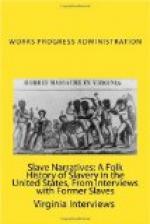Adam Gearheart was a sportsman and used negro Jockeys. His best jockey, Dennis, was sold to Morg. Clark, John’s Creek. The old race track took in part of the east end of the present Prestonsburg—from Gearheart’s home East in Mayo’s bottom one mile to Kelse Hollow—Jimmie Davidson now lives at the beginning of the old track, near Maple Street. Mike Tarter of Tennessee, Gearheart’s son-in-law brought horses from Tennessee and ran them here. Tarter was a promoter and book-maker also. Penny J. Sizemore and Morg. Clark were other sportsmen. This was as early as 1840 up to the Civil War.
Slaves ware traded, bought and sold between owners just as domestic animals are today. Where one owned only a few servants with no families they lived in the big house—otherwise in Slave quarters, little cabins nearby.
Billy Slone just had two female servants, he bought them in Virginia 15 years old, for $1,000.00 sound.
Many folk went over to Mt. Sterling or Lexington to auctions for trading servants. (The same manner is used trading stock today).
Slave traders came into the county to buy up slaves for the Southern plantations, and cotton or sugar fields—Slave families were very frequently separated, some members mean, theiving, or running away niggers were sold (first) down the river. Sometimes good servants were sold for the price, the master being in a financial strait or dire need of money. Traders handcuffed their servants purchased, and took them by boat or horse-back down the river or over in Virginia and Carolina tobacco fields.
Good servants were usually well treated and not over-worked. Mean or contrary servants were whipped, or punished in other ways. Run-aways were hunted—dogs being used to track them at times.
George Dorsey:
Although this article is presented in narrative form and has but few characters, the writer believes it to be an excellent example of life in Owen County sixty or more years ago. With the exception of the grey eagle episode, similar events to these described were happening all over the county. There is no reason to doubt the authenticity of any part of the article. The narrator (George Dorsey, age 76 (negro) Owentown, Kentucky, born in slavery and raised by a white family) bears a good reputation and is intelligent enough to react favorably and intelligently to questions concerning the past. Further interviews concerning more general subjects are planned.
“I was born on the 16th day of June, 1860 on the ole poor house farm ’bout two miles from Owentown. My mother yousta tell me I’d be a sleepy head. I didn’t know what she meant by that so finally one day, after I got to be a great big boy, I asked her what she meant.
“Well, she says, Chickens that is hatched in June jess stand ’round in the hot sun an’ sleep themselves to death. So, as you was born in June, you’ll jess be a sleepy head.”




